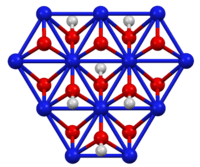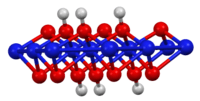Nickel oxide hydroxide
 | |
 | |
| Names | |
|---|---|
| Other names
Nickel Oxyhydroxide | |
| Identifiers | |
| PubChem CID |
|
| Properties | |
| Ni(O)(OH) | |
| Appearance | black solid |
| Except where otherwise noted, data are given for materials in their standard state (at 25 °C [77 °F], 100 kPa). | |
| Infobox references | |
Nickel oxide hydroxide is the inorganic compound with the chemical formula NiO(OH). It is a black solid that is insoluble in all solvents but attacked by base and acid. It is a component of the nickel-hydride battery.
Related materials
Nickel(III) oxides are often poorly characterized and are assumed to be nonstoichiometric compounds. Nickel(III) oxide (Ni2O3) has not been verified crystallographically. For applications in organic chemistry, nickel oxides or peroxides are generated in situ and lack crystallographic characterization. For example, "nickel peroxide" (CAS# 12035-36-8) is also closely related to or even identical with NiO(OH).[1]
Synthesis and structure
Its layered structure resembles that of the brucite polymorph of nickel(II) hydroxide, but with half as many hydrogens. The oxidation state of nickel is 3+.[2] It can be prepared by the reaction of nickel(II) nitrate with aqueous potassium hydroxide and bromine as the oxidant:[3]
- Ni(OH)2 + KOH + 0.5 Br2 → KBr + H2O + 2NiOOH
Use in organic chemistry
Nickel(III) oxides catalyze the oxidation of benzyl alcohol to benzoic acid using bleach:[4]
Similarly it catalyzes the double oxidation of 3-butenoic acid to fumaric acid:
References
- ↑ Gary W. Morrow "Nickel(II) Peroxide" Encyclopedia of Reagents for Organic Synthesis, 2001 John Wiley & Sons. doi:10.1002/047084289X.rn017
- ↑ Casas-Cabanas, M.; Canales-Vazquez, J.; Rodriguez Carvajal, J.; Palacin, M.R. "Characterizing nickel battery materials: crystal structure of beta-(NiOOH)" Materials Research Society Symposia Proceedings (2009) 1126, p131-p136.
- ↑ O. Glemser "β-Nickel(III) Hydroxide" in Handbook of Preparative Inorganic Chemistry, 2nd Ed. Edited by G. Brauer, Academic Press, 1963, NY. Vol. 1. p. 1549.
- ↑ An Efficient and Practical System for the Catalytic Oxidation of Alcohols, Aldehydes, and ,-Unsaturated Carboxylic Acids Joseph M. Grill, James W. Ogle, and Stephen A. Miller J. Org. Chem.; 2006; 71(25) pp 9291 - 9296; (Article) doi:10.1021/jo0612574

